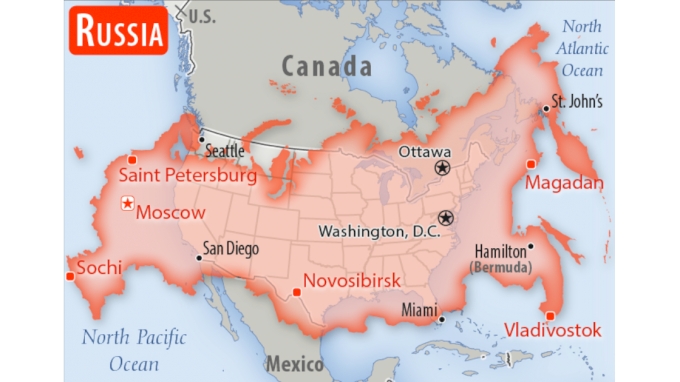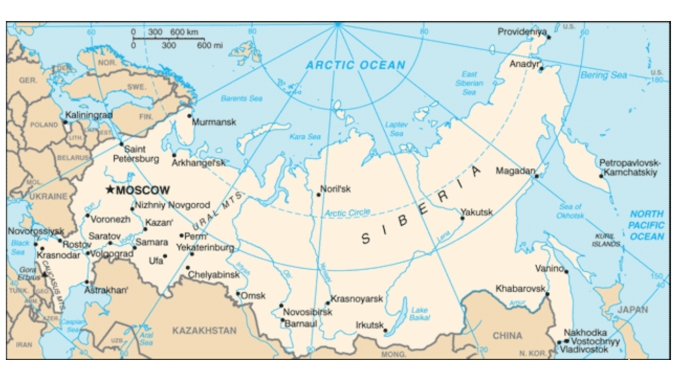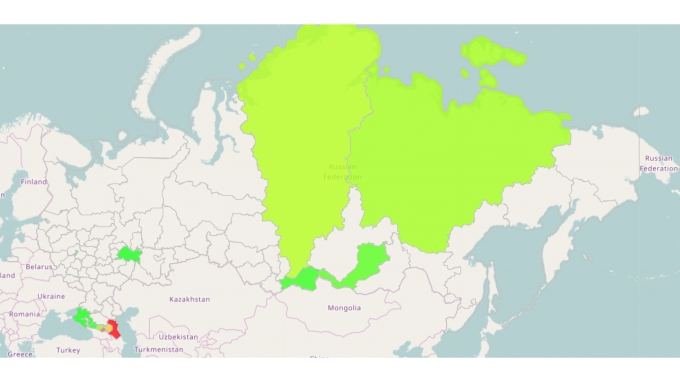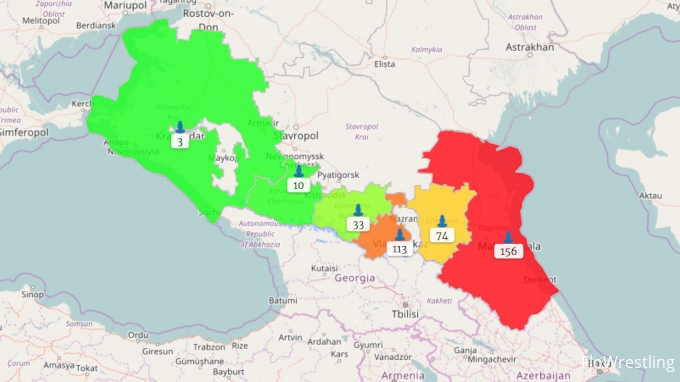Heat Maps For Russian Nationals 2015-2018
Heat Maps For Russian Nationals 2015-2018
Heat maps by region based on results of Russian Freestyle National Championships from 2015 to 2018.

Unlock this article, live events, and more with a subscription!
Already a subscriber? Log In
Russia is a large country. In fact, it is the largest of all the countries, at least when ranked by total land area. It is also very good at wrestling. Some would say the best at it. So where in this vast and expansive country do these very good wrestlers come from? We will find out, using our favorite technological advancement: heat maps!
First, let's get our bearings by taking a look at a map of the Russian Federation, and how it compares in area to that of the contiguous United State of America. And we have just such a map, thanks to our friends at the U.S. Central Intelligence Agency.

And here's another map of Russia without the overlay, also from the CIA (really, the CIA is a great resource for stuff like this, no kidding).

Russia spans 11 time-zones. So yeah, that's a lot of land.
Regarding the heat maps, to get an idea of where all these Russian wrestlers are coming from we took the results of the last four Russian Freestyle National Championships and awarded points to wrestlers placing first, second, and third, and then assigned those points to the region of origin for those wrestlers who earned Russian medals.
Since UWW recently updated their tournament scoring rules (article 33), we've adapted them here: 25 for first, 20 for second, and 15 for third. Then we divided by the lowest common denominator to get five, four, and three for our point totals.
There are a couple things to note about the business of assigning points to the wrestlers' regions of origin. First, it's an inexact science. Just like NCAA wrestlers' "home states," there's no hard and fast rule for deciding to which region a Russian wrestler's points "belong."
Second — and this could be a much longer digression but I'll try to keep it brief — Russia is not a homogenous country, divided into uniform states, or provinces, or departments, etc. It is in many ways the successor state to the Soviet Union, which was itself a reconstitution of the Tsarist Russian Empire. It is an unwieldy amalgamation of sub-national governing bodies that combine to form the Russian Federation. As such, each region is some form of either republic, oblast, okrug, krai, or autonomous city, all with various histories, demographics and specific place within the Russian Federation. The names of the regions are immaterial here but it's worth keeping in mind just how diverse a country Russia is we break down the heat map.
So let's get to the heart map already.  Right off the bat, apologies for the Mercator projection; it could not be avoided. Those giant green blobs in the upper right corner of the country are massive areas of land, but they are not that massive. Also worth noting that those green blobs are very sparsely populated. It's Siberia, not a lot of people want to live there (no offense to the Siberians).
Right off the bat, apologies for the Mercator projection; it could not be avoided. Those giant green blobs in the upper right corner of the country are massive areas of land, but they are not that massive. Also worth noting that those green blobs are very sparsely populated. It's Siberia, not a lot of people want to live there (no offense to the Siberians).
However, despite the limited talented pool and inhospitable climate, those four regions produced quite a few international hammers. Let's zoom in for a closer look at Siberian wrestling.

As you can see, Siberia is way up north, with its closest neighbors being Mongolia and the terribly frigid parts of China and Japan. It's also firmly on the Asian side of the country, and that influence will be born out when we get into the demographics of each region.
That's 41 points for Krasnoyarsk, home of the prestigious Ivan Yarygin Tournament. Other native sons of Krasnoyarsk of a more recent vintage include multiple-time Yargyin champ and European bronze medalist Israil Kasumov.
Krasnoyarsk is also the largest producer of ethnic Russians that have won medals at Russian Nationals, like Yuri Belonovski, although ethnic Russian medal winners at RusNats are few and far between.
I know it sounds odd to think of Russians being a minority at the Russian Nationals, but "Russians" only make up about three-quarters of the population of the Russian Federation. It requires a much longer digression but it's good to remember that the vast majority of Russians who compete and win medals at the world champions are ethnic minorities for whom Russian is not their first language.
For instance, Tuva is a republic that earned 14 "points" by our reckoning over the last four years at Russian Nationals. It's the green blob in the lower left of the above map. Tuvans, like Khuresh-ool Donduk-ool and 2017 U23 world champion Nachyn Kuular, most likely speak Tuvan as their first language (a distant cousin of Turkish) and are Buddhist, rather than Eastern Orthodox Chrisitan, like most ethnic Russians.
Next to Tuva is the Republic of Buryatia, which is shaped like a backward J and scored 22 points. Buryatians, like fan-favorite and European gold medalist Aleksandr Bogomoev, speak a dialect of Mongolian, though are predominately Orthodox Chrisitan, unlike their Buddhist neighbors to the south and west.
Finally, there is Sakha Republic, home of ALROSA, one of the world's largest diamond mines and main sponsor of the Russian wrestling team. The capital of the Sakha Republic is Yakutia, home of two-time world medalist and Olympian Victor Lebedev. Lebedev is Evan, a minority even in Yakust, who speaks a language totally unrelated to all but a few other small population groups in Northern Siberia, which is just another example of the stunning diversity hidden within modern-day Russian.
But Siberia is not the true hotbed Russia wrestling. That would be the vaunted Caucuses region in Southern Russia, from whence so many great champions of the sport hail. Let's take a closer look at the North Caucuses, replete with Russian hammers.

The true giant of Russian wrestling can be found colored in deep red. With 156 "points," the Republic of Dagestan stands out as the font of wrestling powerhouses.
What's even more incredible is that Dagestani wrestlers earned the most points at Russian Nationals by a large margin and did so while boycotting the 2016 tournament, due to events too convoluted to get into, although more on the subject can be found here.
What's more, Dagestan is famous for their "legionnaires" or native Dagestanis who compete for other nations. For instance, Dagestanis that won medals for other countries at the Rio Olympics include Sharif Sharifov for Azerbaijan, Ibrahim Saidau for Belarus, and Magomed Ibragimov for Uzbekistan, among many other non-medaling Olympians.
Some of the Dagestani superstars who have won world or Olympic gold medals and competed at Russian Nationals over the last four years include over the Abdulrashid Sadulaev, Abdusalam Gadisov, Magomedrasul Gazimagomedov, and Magomed Kurbanaliev.
Dagestan is also home to a mind-boggling array of ethnicities and languages, some native only to the North Caucuses. More than 30 total languages are spoken by Dagestan's approximately three million inhabitants, the vast majority of whom are practicing Muslims.
Our next most productive region of Russia is the Republic of North Ossetia-Alania. Ossetians are a unique people in the world in that they speak a dialect of Farsi (or a related language, depending on who you ask) but are predominately Eastern Orthodox Christian, the only Christian Persian population of significance. Ossetians can also be found on the north and south side of the Caucuses Mountains.
Olympic champion Soslan Ramonov, for example, is from South Ossetia, which is technically part of Georgia, unless you're asking a Russian or South Ossetian; in that case, they will likely tell you it is an independent nation. On the other side of the range is world champion Kheteg Tsabolov from North Ossetian. As is Khetag Gozyumov, who won eight world and Olympic medals while competing for Azerbaijan. Ossetians are also known for their legionnaires like their rivals, the Dagestanis.
Chechnya is third on our list. Chechen greats include Anzor Boltukaev and Bekkhan Goigereev, and the GOAT, Buvaisar Saitiev, although Satiev was born in Khasavyurt, which is technically in Dagestan (see, I told you this was complicated). Chechen-Russo relations stretch back centuries and contain enough sordid to fill volumes of textbooks. Some of those books are even pretty decent reads, too.
Finally, in descending order of points, the North Caucuses regions of note include Kabardino-Balkaria, Karachay-Cherkessia, and Krasnodar. Aniuar Geduev is Kabardian and Khuseyn Suyunchev is Cherkess, both in the North Caucuses ethnolinguistic family. Balkarians and Karachans, on the other hand, are Turkic people. The reason a Caucasian and Turkic population are paired together in those republics is that, when Joseph Stalin was crafting them from thin air, he preferred to force unrelated people to share a constituency so that neither could consolidate power and form a threat. Stalin was infamously paranoid.
All right, I think that will more than do it for now. Apologies for the longwindedness. To cap things off, below is a reckoning of all the point scoring regions of Russia form 2015-18.
| REGION | POINTS |
| Dagestan | 156 |
| North Ossetia-Alania | 113 |
| Chechnya | 74 |
| Krasnoyarsk Krai | 41 |
| Sakha Republic | 38 |
| Kabardino-Balkaria | 33 |
| Buryatia | 22 |
| Tuva | 14 |
| Karachay-Cherkessia | 10 |
| Moscow | 7 |
| Tatarstan | 3 |
| Krasnodar Krai | 3 |
Thanks for reading. Hope you all enjoyed the tour of Russia as much as I did!